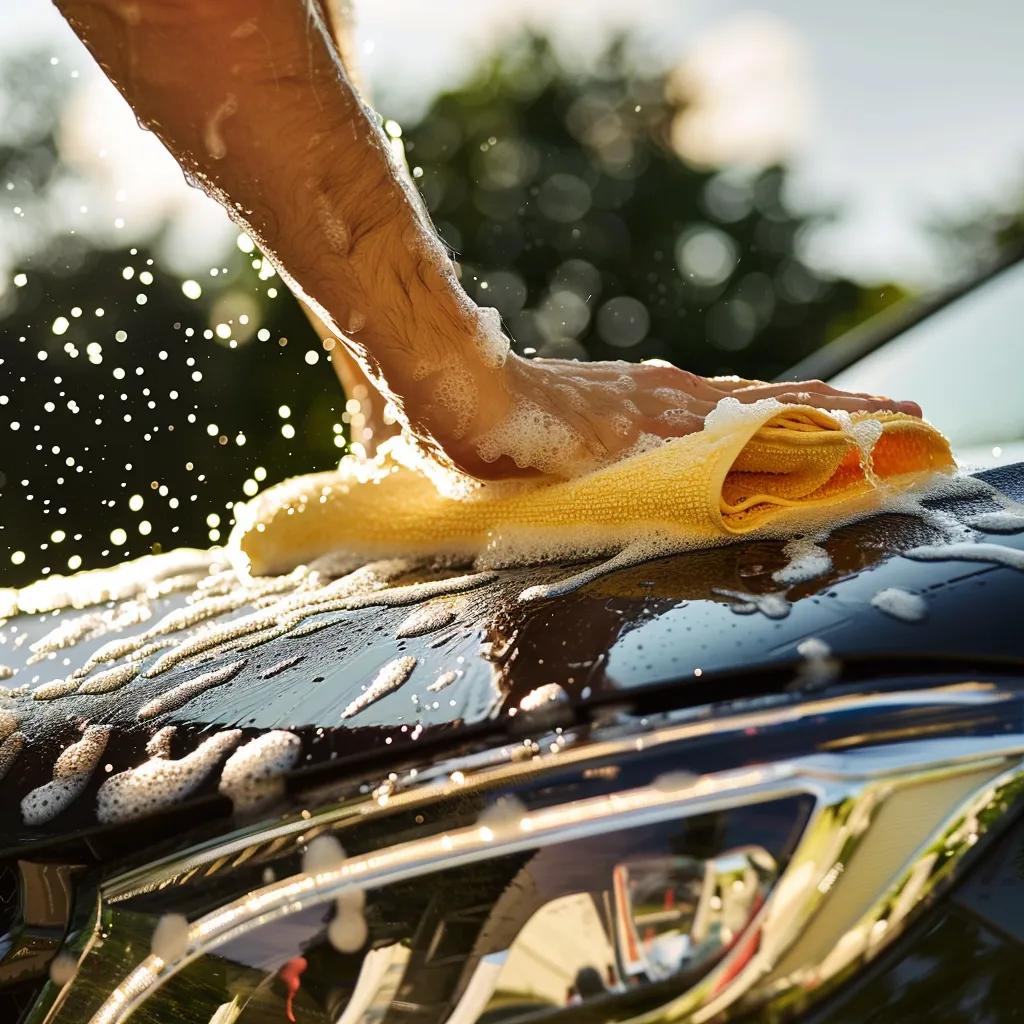
How to Remove Water Spots from Your Car Paint
How to Remove Water Spots from Your Car Paint: Effective Cleaning and Prevention Guide
Water spots are unsightly mineral deposits that form when water evaporates on your car’s clear coat, leaving chalky white rings that dull the finish and can etch into the paint. In this guide, you’ll uncover what water spots are, how they develop, and practical steps ranging from simple DIY solutions like vinegar and clay bars to advanced commercial removers and professional detailing options, to restore showroom shine.
You’ll also learn essential prevention tactics, from proper washing and drying techniques to protective coatings that shield your paint. Along the way, discover the tools and products that make removal easy and eco-friendly, and decide when a mobile detailing service, backed by our expertise at washcar.sg, can save you time and deliver flawless results.
What Are Water Spots on Car Paint and How Do They Form?
Water spots are hard water or environmental residues left behind after droplets dry, creating mineral films that weaken the clear coat. These deposits form when water containing calcium, magnesium, or acid rain sits on the surface, evaporates, and leaves solids that bond to automotive paint. For example, Singapore’s mineral-rich tap water often results in visible white speckles after rainfall or car wash rinse, signaling the start of potential clear coat etching and discoloration.
What Causes Water Spots on Car Paint?
Hard water contains calcium and magnesium that crystallize upon evaporation.
Acid rain deposits sulfates and nitrates, which corrode clear coat layers.
Sprinkler systems or dew can mist your car with mineral-laden droplets.
These causes punctuate each washing or rainfall event, emphasizing why timely removal and protective measures are crucial for maintaining paint integrity and gloss.
What Are the Different Types of Water Spots?
Mineral Deposits: White, chalky films from evaporated hard water.
Bonded Stains: Dark rings where minerals have chemically bonded to clear coat.
Etching: Shallow pitting when acidic deposits eat into the paint layer.
Understanding these categories helps you choose a removal method that addresses both surface residue and any underlying clear coat damage.
How Can You Identify Water Spot Severity on Your Car Paint?
Stage 1 (Light): Surface mineral dust removable by gentle vinegar rinse.
Stage 2 (Moderate): Bonded deposits requiring clay bar treatment.
Stage 3 (Severe): Etched or acid-rain pitting that demands polishing or correction.
Spot severity dictates whether you need simple DIY tactics or professional-grade polishing to fully restore the finish.
What Are the Best DIY Methods to Remove Water Spots from Your Car?

DIY water spot removal balances effectiveness with cost-efficiency by using common household supplies. Home methods break down mineral bonds without harsh abrasives, preserving your clear coat while restoring shine.
How to Use a Vinegar Solution to Remove Light Water Spots?
Mix equal parts distilled white vinegar and filtered water.
Spray onto affected panels and let sit for 1–2 minutes.
Gently wipe with a clean microfiber towel.
Rinse with deionized water and dry immediately to prevent new spots.
This acidic rinse neutralizes calcium and magnesium residues, and following up with a quick rinse prevents lingering acidity and readies the surface for wax protection.
How Does Baking Soda Paste Help Remove Water Stains?
Combine 3 tablespoons of baking soda with just enough water to form a paste.
Apply paste in circular motions with a damp microfiber applicator.
Rinse thoroughly and dry with a separate towel.
The paste’s fine particles gently lift bonded deposits without scratching, making it ideal after a vinegar treatment and before protective coating.
When and How to Use a Clay Bar for Bonded Water Spots?
Wash the car with pH-neutral shampoo and rinse.
Lubricate the panel with clay lubricant.
Glide the clay bar across the surface using light pressure.
Wipe away residue with a microfiber cloth.
Clay removes fine bonded contaminants that simple cleaners can’t, preparing paint for polish or sealant and preventing premature coating wear.
What Tools and Products Are Needed for DIY Water Spot Removal?
Effective DIY removal relies on a concise toolkit:
Microfiber towels for scratch-free drying
pH-neutral car shampoo to remove loose dirt
Distilled white vinegar to dissolve mineral films
Baking soda for gentle abrasion
Clay bar with lubricant for decontamination
Best Microfiber Towels for Car Detailing
Microfiber towels are essential for car detailing due to their softness, high absorbency, and durability, which prevent scratches and ensure a flawless finish. These towels are available in various GSM (grams per square meter) weights, with higher GSMs being suitable for delicate surfaces like paint and mirrors.
Fresh Layer Mobile Detailing, The Best Microfiber Towels for Cars in 2025 (2025)
This research supports the article's recommendation of using microfiber towels for water spot removal and general car care.
pH-Neutral Car Shampoos for Safe Cleaning
pH-neutral car shampoos are crucial for preserving the paintwork and protective coatings of a vehicle. These shampoos effectively remove dirt and contaminants without stripping away wax or sealants, ensuring the longevity of the car's finish.
Killer Brands UK, The Importance of pH-Neutral Car Shampoos (2023)
This research supports the article's recommendation of using pH-neutral car shampoos for safe and effective cleaning.
What Advanced Techniques and Products Remove Stubborn Water Spots?
How Do Commercial Water Spot Removers Work and Which Are Best?
Commercial removers use acid-based or alkaline formulas to target mineral bonds and organic deposits.
When Is Paint Polishing or Correction Necessary for Etched Spots?
Compounding: Use a medium-cut polish on a dual-action polisher to remove surface irregularities.
Fine Polishing: Follow with a fine polish pad to restore gloss.
Inspection: Wipe clean and inspect under bright light for uniform clarity.
This multi-step correction literally shaves away damaged clear coat layers, leveling the surface and restoring depth before any protective sealant is applied.
When Should You Consider Professional Detailing Services?

DIY methods suffice for surface residues, but professional detailing becomes cost-effective for:
Widespread etching beyond Stage 2 severity
Time-constrained schedules where mobile services bring premium tools to you
Ensuring warranty-safe coatings by certified applicators
Experts employ advanced polishing machines, bespoke ceramic coatings, and tailored decontamination steps, guaranteeing long-term protection and flawless results.
How Can You Prevent Water Spots from Forming on Your Car Paint?
What Are Proper Car Washing and Drying Techniques to Avoid Spots?
Rinse thoroughly before soaping to remove loose grit.
Use pH-neutral shampoo to prevent film formation.
Dry immediately with a plush microfiber towel, working panel by panel.
Prompt drying stops minerals from settling, and a two-bucket wash system avoids redistributing contaminants that can etch clear coat.
How Do Waxes, Sealants, and Ceramic Coatings Protect Against Water Spots?
Protective layers create hydrophobic barriers that prevent water from clinging:
Paint Protection Film (PPF)
Paint protection film (PPF) is a transparent polyurethane film designed to protect a car's paint from damage. PPF works by absorbing and dispersing the energy of impacts, preventing them from reaching the paint, and is also resistant to UV radiation and chemicals.
Avery Dennison Graphics Solutions, The Science Behind Paint Protection Films (2025)
This research supports the article's discussion of protective coatings and their role in preventing water spots.
How Does Using Deionized or Filtered Water Help Prevent Spots?
Deionized or filtered water eliminates mineral content, ensuring rinse water leaves no deposits behind. Using a filtered rinse or purified water sprayer after washing guarantees a spotless finish and extends the life of waxes or coatings by preventing contaminants from embedding in the clear coat.
What Environmental Factors Increase Water Spot Risks and How to Mitigate Them?
Avoiding parking near overhead sprinkler systems.
Washing under shaded areas to slow evaporation.
Scheduling rinse-and-dry sessions shortly after rainfall.
By adapting your routine to environmental conditions, you minimize spot formation before it begins.
Which Essential Tools and Products Are Recommended for Water Spot Removal and Prevention?
What Are the Best Microfiber Towels and Applicators for Car Paint Cleaning?
A high-pile microfiber towel with split fibers lifts minerals without scratching. Microfiber applicators with soft foam backing apply pastes and polishes evenly, preventing swirl marks. These tools form the foundation of scratch-free cleaning and maintenance.
How to Choose pH-Neutral Car Shampoos for Safe Cleaning?
Select shampoos labeled pH 7–8 that contain gentle surfactants and corrosion inhibitors. These formulas remove dirt and oils without stripping wax or sealant layers, maintaining protective barriers and minimizing spot-forming residues.
What Are the Top-Rated Water Spot Remover Products Compared?
Below is a comparison of leading professional-grade removers:
How Do Paint Protection Products Differ: Wax vs. Sealant vs. Ceramic Coating?
What Are Common Questions About Removing Water Spots from Car Paint?
Can Vinegar Damage Car Paint When Removing Water Spots?
No, when diluted correctly, distilled white vinegar is safe for clear coats. Vinegar’s mild acidity dissolves mineral buildup without stripping protective wax, provided you rinse thoroughly and dry immediately after treatment.
Are Water Spots Permanent on Car Paint?
Only severely etched spots become permanent without correction. Surface mineral films are removable with DIY methods, but deep acid-rain or chemical etching that pits clear coat requires professional polishing to fully restore.
How Do You Remove Stubborn Water Spots Safely?
Vinegar rinse to soften minerals.
Clay bar to decontaminate.
Compound polishing to erase etching.
Protective sealant to shield the treated area.
This progressive approach ensures you tackle residues without over-abrading the paint.
What Is the Best Product for Water Spots on Cars?
The best product matches spot type: mild citric acid gels for light mineral films, stronger hydrochloric formulations for etched stains, and polymer-based neutralizers for resin-like deposits. Always follow manufacturer guidelines and test on an inconspicuous patch.
How to Choose the Right Water Spot Removal Method Based on Spot Severity?
When Is DIY Removal Sufficient vs. Professional Detailing Needed?
DIY tactics suit Stage 1–2 spots that remain on the surface. Stage 3 etching and widespread pitting benefit from professional detailing, where experts use machine polishers and high-grade compounds to restore clarity without compromising clear coat thickness.
How to Match Removal Techniques to Water Spot Types?
Match techniques by categorizing your spots:
Surface mineral deposits → Vinegar or baking soda paste
Bonded contaminants → Clay bar treatment
Pitted or etched spots → Polishing and compounding
Aligning strategy to deposit chemistry avoids wasteful trial-and-error and reduces paint damage risk.
What Are the Risks of Incorrect Water Spot Removal?
Using overly aggressive abrasives on light deposits can remove wax or clear coat. Inadequate decontamination leaves residues that degrade coatings prematurely. Following severity-based methods ensures you protect paint integrity while eliminating spots.
How to Maintain Your Car Paint After Water Spot Removal?
What Are the Best Practices for Regular Car Paint Cleaning?
Weekly washes with pH-neutral shampoo and gentle microfiber drying prevent contaminant buildup. Applying a quick detailer spray after rinse helps lift residual minerals and maintains hydrophobic properties between full treatments.
How Often Should You Apply Wax, Sealant, or Ceramic Coating?
How to Monitor and Address New Water Spots Early?
After each wash or rain event, inspect the paint under bright daylight, focusing on horizontal surfaces. Addressing Stage 1 spots within 24 hours prevents mineral bonding and preserves clear-coat shine until your next scheduled maintenance.
Water spots may start small and treatable, but through targeted removal, protective coatings, and proper maintenance, you can maintain a spotless finish and safeguard your car’s value. Consistent care—whether at home or through professional mobile detailing—ensures your vehicle always looks its best and enjoys long-lasting paint protection.

